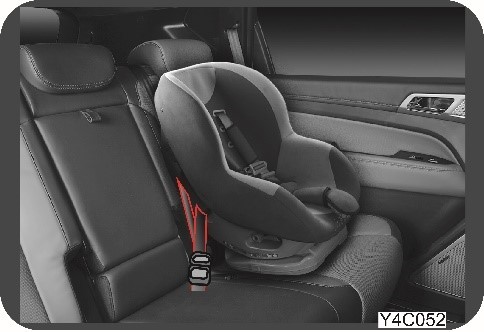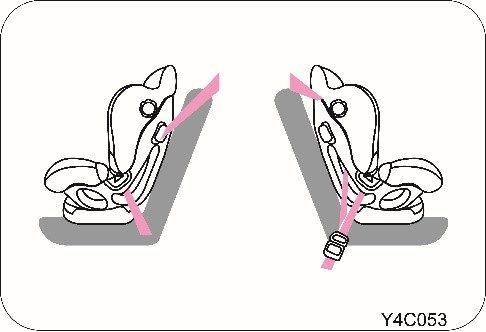Driving child safety forward
As more cars come equipped with child safety features today, it’s important to understand how to use them to their full potential. In our previous blog, we looked at rear facing child seats, intended to be used for infants under 2 years of age. As your children outgrow their rear facing seats, forward-facing seats become suitable for them. Let’s learn more about these seats and how to use them correctly.
Forward-facing child seats
As your child grows beyond 2 years of age, their necks and back grow stronger. They are able to safely withstand the forces of regular travel provided they are strapped in correctly. Forward facing child seats are usually designed for children in the 2-4 age group, weighing anywhere between 13-18 kgs. These seats typically come with their own harness, in a variety of configurations and styles. We suggest a 5-point harness to ensure that your child stays safe and comfortable.
Safely installing the front facing child seat
When it comes to fastening the seat, there are two options. The first method is using ISOFIX which is a special locking mechanism that is the international standard for attachment points for child seats and restraints.
-
You should install the front facing seat in the rear seat of your vehicle. This is the safest spot for your child in the car.

Take the hooks provided at the bottom of the child seat and attach them to the ISOFIX anchors under the cushion of the backrest of the seat. If you have difficulty locating any of the ISOFIX anchors, refer to the vehicle owner’s guide.
After connecting both hooks to the anchors, pull on the straps to ensure they are tight and the seat doesn’t move from side to side. This is essential because sideways movement will compromise the safety of your child
Some child seats might come with an additional provision of securing them with anchors provided at the back of (some) vehicle’s seats. For such seats, locate the top tether strap of the child seat and hook it to the anchor at the back of the car’s seat. Accessing the anchor through the back of the car may be easier. Again, pull on the straps while holding the seat firmly against the vehicle seat, to make sure that it’s secure. This tether ensures that the seat doesn’t move forward in case of a crash. The rear anchor is a supplemental device to secure the child restraint system after engaging it by the lower latches. Therefore, do not secure the child restraint system only with the seat back anchors.
The second option for fastening the child seat is with the standard 3-point seatbelts in the rear seat. Here’s how:
Run the car seatbelt, through the demarcated slots in the back of the child seat and lock it in. Once locked, pull on the seatbelt to make sure it’s tight while holding the child seat down securely.
Shake the seat to ensure that it remains tightly in place and doesn’t move sideways or forward.
Keep in mind that you can’t adjust the angle of the backrest with the child seat installed. If you’re trying to do so, the seat belt will be slack, which incurs danger. Always adjust the angle of the backrest before installing the child seat
Harnessing your child safely
Now that the child seat is secured in place, we need to make sure that your child is safely buckled in. Depending on your seat and its features, the harness will work differently. However, here are a few points to keep in mind while securing your child in the seat.

-
Listen for the click while attaching the buckle to confirm that the harness is clipped in securely.
-
Pull on the fasteners to make sure that your child is held snugly in the seat. As a quick check, if you can easily pinch the harness between your fingers, it’s too loose. Tighten it a little more and check again.
However, make sure that the harness is not so tight that it restricts your child’s breathing.
Ensure that the seat is at an appropriate angle, usually 30-45 degrees. Child seats usually come with adjustable backs or bases and angle indicators which can help you set the angle correctly. A seat that’s set too upright or flat can be hazardous.
Important points to note
Do not install the child restraint if it hinders the operations of the driver seat. Use a different safe position in the vehicle.
All the procedures described here are to assist you in understanding the child restraint system. Use this as a reference only. When you install a child restraint to your vehicle, observe instructions for installation in the manual provided by the seat manufacturer & also your vehicle’s manual.
Front facing seats also come with specified minimum height and weight requirements. It’s recommended to follow these guidelines strictly and prioritize them over the age suggestions
Similarly, it’s recommended that kids continue using the front facing seats before moving to a booster seat, until they reach the height or weight limit of the seat. Look for a seat with additional height and weight limits so you can use the seat for a longer duration.
When your child restraint is not in use, remove it from the vehicle or keep it secured with a seat belt to prevent it from being thrown forward in case of a sudden stop or an accident. Child seats are rendered useless after an accident, irrespective of whether the child is in the seat or not. It’s advisable to replace the child seat in case the car meets with an accident with the seat installed, to ensure your child’s safety in future drives.
Child restraint anchorages are designed to withstand only those loads imposed by correctly fitted child restraints. Under no circumstances are they to be used for adult seat belts, harnesses or for attaching other items or equipment to the vehicle.
Remember that a child restraint seat left in a concealed vehicle can cause it to be very hot. Check the seating surface before seating your child in the child restraint
When installing a child restraint, do not let the seat belts come across the child’s neck
With front facing seats, your child can now enjoy the same view as you. Keep an eye out for more such child safety tips in our #ChildSafetyOnTheGo series!